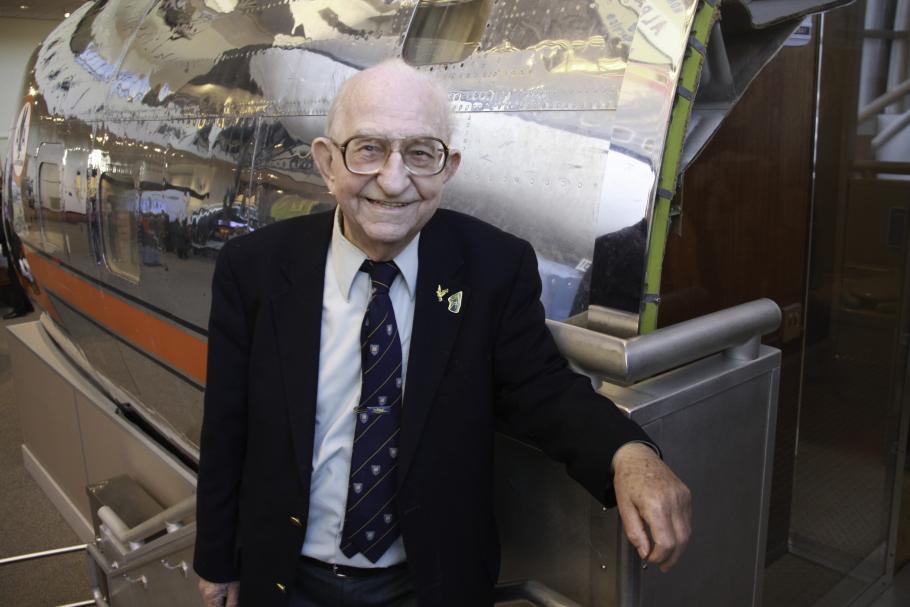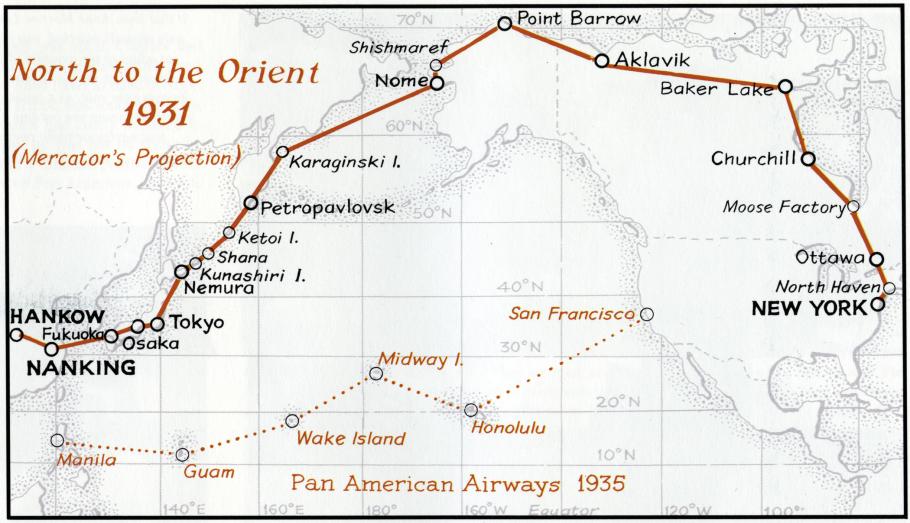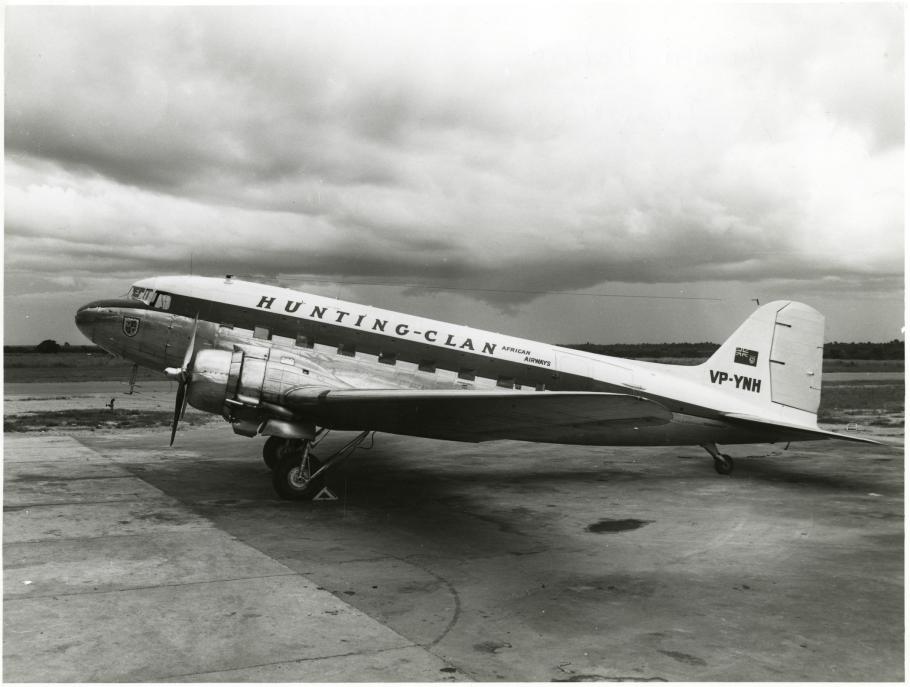Early in my time as an archivist for the National Air and Museum Archives, I had a question about an obscure airline. I had checked the Technical Reference Files and other collections. My colleague led me down the hallway to the Aeronautics Department and introduced me to curator R.E.G. “Ron” Davies. In a soft British accent, Ron showed me his “dossiers,” what felt like hundreds of three-ring binders labelled meticulously in an artistic hand, dominating an entire wall, ceiling to floor. He reached high above his head to present me with a file on the airline, complete with a handwritten timeline from the founding through mergers and the ultimate end, a hand drawn map of the routes, pencil drawings of the airline’s colors, and contemporary articles about the airline. He then motioned to several short, custom-made wooden filing cabinets filled with hundreds of thousands of airline timetables. What a treasure trove and what a fascinating person to have collected all of this!
R. E. G. (Ron) Davies, Curator of Air Transportation, Smithsonian National Air and Space Museum, poses standing at top of exit stairs beside the Douglas DC-7 forward fuselage (A19660149000) in the museum's "America By Air" exhibit (Gallery 102), Washington, D.C., February 11, 2011.
Ronald Edward George Davies, known professionally as R.E.G. Davies and to his friends and colleagues as Ron, was born in England in 1921. He spent six and a half years in the British Army, even driving a machine gun carrier onto the banks of Normandy during World War II. Postwar, he joined the newly formed Ministry of Civil Aviation.
The rest of Davies’ career was spent researching aviation, while specializing in economic, market research, and traffic analysis. In 1968, Davies moved to the United States for Douglas Aircraft, where he remained for 13 years as head of market research. In 1981, Davies was appointed as the Charles Lindbergh Chair of Aerospace History at the National Air and Space Museum, Washington, DC. After his appointment as Lindbergh Chair ended, Davies became a curator in the Aeronautics Division of the Museum. He retired in 2011 and passed away the same year.
Mercator map projection by R.E.G. Davies showing the route of Charles and Anne Morrow Lindbergh's 1931 flight from New York to China with a comparison of Pan American Airways’ 1935 Pacific route below.
Throughout his career, Davies collected everything—and I mean everything—from airlines around the world. He kept the tickets, timetables, brochures, photographs, public relations releases, and baggage labels from his travels. He encouraged his friends and colleagues to save their materials for him. He wrote to airlines and aircraft manufacturers soliciting information. This material, totalling over 62 cubic feet, became the basis for the R. E. G. (Ron) Davies Air Transport Collection at the National Air and Space Museum Archives.
"Happy New Year." Greeting card issued by Pan American Airlines (PAA), inside reads: Greetings and best wishes for a happy New Year - PAA - FLIGHT RADIO OFFICERS, Pacific Division. Officers are listed by name with code letters. Hidden interior of card has handwritten note, "1938 This card was sent to Pop."
Countries have come and gone. Davies’s collecting was constant, an intriguing study of how to organize an ever-growing collection in an ever-changing world. Davies chose a geographic organization by continent and region, beginning where and when he began, as an Englishman in a post-WWII world where the European colonial empires were just beginning to be dismantled. He consistently maintained this general structure, rather than rearrange to match new, sometimes short-lived, geopolitical changes. West Africa is notably divided between French Sub-Sahara and non-French. Cambodia, Laos, and Vietnam are filed together as Indo-China. Asia is frequently referred to as the Orient in early writings. The shadow of the Soviet Union looms large in the organization—former Soviet republics share a binder and the airlines of Croatia, Serbia, Slovenia, Macedonia, and Bosnia and Herzegovina are still filed under Yugoslavia (sometimes spelled with a phonetic “J”).
Left side view of Hunting Clan African Airways Douglas DC-3 (r/n VP-YNH) on the ground, probably in Rhodesia (colonial British West Africa, later Zimbabwe), circa 1955-1960.
Airlines have also come and gone. In the United States, Davies organized his materials by type of airline and separated them by media—dossiers (the large binders), photographs, and timetables. The largest section in each is the trunk airlines, authorized to provide interstate service by the Civil Aeronautics Act of 1938. These include airlines that are still flying like American, United, and Delta and other well-known trunks that have either merged with others, like Capital and Continental, or have ceased operations, like Eastern and Pan American. The collection is rich with lesser-known airlines, such as local service/regional airlines, which proliferated in the 1950s and 1960s; supplemental airlines (whose definition is difficult to condense, as it covers an entire chapter of Davies’ seminal work Airlines of the United States), helicopter airlines, commuter airlines, and post-deregulation start-ups.
Left side view of People Express Airlines (PEOPLExpress) Boeing Model 747-200 on the ground at an unidentified airport; access stairs drawn up to forward passenger door; circa 1981-1987.
Airline timetables evolved from simple sheets of paper with typed times on them to three-fold (or larger) works of art. Schedules were often updated weekly or monthly. By the early twenty-first century, many timetables are thick informational booklets. With airlines able to update their schedules more easily online, actual physical timetables became less necessary—some of the most recent acquisitions in Davies’ collection are marked “last printed timetable.”
Front cover of advertising brochure and timetable issued by North American Airlines, circa 1955. This airline existed from 1950 to 1957. In 1956, North American Airlines was forced to change its name after a court proceeding found that use of the name "North American" had created "substantial public confusion" with American Airlines and constituted unfair competition. The company was prohibited from using "North American Airlines" or any combination that included the word "American." The company changed its name to Trans American in 1956 and ceased operations in 1957.
Interior page of advertising brochure and timetable issued by North American Airlines, circa 1955. This airline existed from 1950 to 1957. In 1956, North American Airlines was forced to change its name after a court proceeding found that use of the name "North American" had created "substantial public confusion" with American Airlines and constituted unfair competition. The company was prohibited from using "North American Airlines" or any combination that included the word "American." The company changed its name to Trans American in 1956 and ceased operations in 1957.
Interior page of advertising brochure and timetable issued by North American Airlines, circa 1955. This airline existed from 1950 to 1957. In 1956, North American Airlines was forced to change its name after a court proceeding found that use of the name "North American" had created "substantial public confusion" with American Airlines and constituted unfair competition. The company was prohibited from using "North American Airlines" or any combination that included the word "American." The company changed its name to Trans American in 1956 and ceased operations in 1957.
Interior page of advertising brochure and timetable issued by North American Airlines, circa 1955. This airline existed from 1950 to 1957. In 1956, North American Airlines was forced to change its name after a court proceeding found that use of the name "North American" had created "substantial public confusion" with American Airlines and constituted unfair competition. The company was prohibited from using "North American Airlines" or any combination that included the word "American." The company changed its name to Trans American in 1956 and ceased operations in 1957.
Back cover of advertising brochure and timetable issued by North American Airlines, circa 1955. This airline existed from 1950 to 1957. In 1956, North American Airlines was forced to change its name after a court proceeding found that use of the name "North American" had created "substantial public confusion" with American Airlines and constituted unfair competition. The company was prohibited from using "North American Airlines" or any combination that included the word "American." The company changed its name to Trans American in 1956 and ceased operations in 1957.
In later years, Davies relied heavily on his cadre of volunteers in the Museum’s Aeronautics Department to integrate new acquisitions into the collection. Most photographs in the collection are painstakingly arranged by geographic region, airline type, airline name, and often aircraft type. They even include a label on the back listing airline name, aircraft model, and special features (such as registration number, location, if in color, date, etc.) An Archives volunteer rehoused and inventoried the photographs series in the late 2000s. Alas, there were still files of materials with notes for his volunteers when the Archives received the collection upon his retirement.
Three-quarter right front view of Compañía Aeronautica Francisco Sarabia SA (CAFSSA) Bellanca Pacemaker CH-300 (r/n XA-BJR) on the ground at Chiapas, Mexico; circa 1930s.
I was fortunate to be assigned to process Ron’s collection and write a finding aid to help researchers understand and access the collection in the National Air and Space Museum Archives. Just like my first foray into Ron’s office, I learned about long forgotten airlines and found many gems. It was hard to not stop and fully read the brochures and timetables, imagining myself on an early transatlantic flight or planning a tour of Yellowstone, arriving on National Parks Airways. Through his collection, these historical airlines will always fly.
____________
The R. E. G. (Ron) Davies Air Transport Collection is processed with a finding aid, featuring a box and folder listing, in the Smithsonian Online Virtual Archives (SOVA). Though select photographs and other items have been digitized throughout the years (digital materials are marked with a blue photo/film icon), the majority of the collection can only be accessed through an in-person research appointment to the National Air and Space Museum Archives. Davies’ many books, with research drawn from his dossiers, photographs from the collection, and featuring his hand-drawn maps and charts, can be found at the National Air and Space Museum Library, as well as many local libraries and bookstores.






